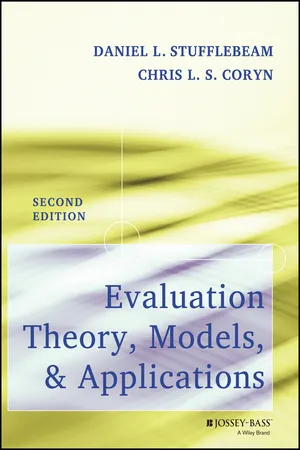
- English
- ePUB (mobile friendly)
- Available on iOS & Android
Evaluation Theory, Models, and Applications
About this book
Now in its second edition, Evaluation Theory, Models, and Applications is the vital text on evaluation models, perfect for classroom use as a textbook, and as a professional evaluation reference. The book begins with an overview of the evaluation field and program evaluation standards, and proceeds to cover the most widely used evaluation approaches. With new evaluation designs and the inclusion of the latest literature from the field, this Second Edition is an essential update for professionals and students who want to stay current. Understanding and choosing evaluation approaches is critical to many professions, and Evaluation Theory, Models, and Applications, Second Edition is the benchmark evaluation guide.
Authors Daniel L. Stufflebeam and Chris L. S. Coryn, widely considered experts in the evaluation field, introduce and describe 23 program evaluation approaches, including, new to this edition, transformative evaluation, participatory evaluation, consumer feedback, and meta-analysis. Evaluation Theory, Models, and Applications, Second Edition facilitates the process of planning, conducting, and assessing program evaluations. The highlighted evaluation approaches include:
- Experimental and quasi-experimental design evaluations
- Daniel L. Stufflebeam's CIPP Model
- Michael Scriven's Consumer-Oriented Evaluation
- Michael Patton's Utilization-Focused Evaluation
- Robert Stake's Responsive/Stakeholder-Centered Evaluation
- Case Study Evaluation
Key readings listed at the end of each chapter direct readers to the most important references for each topic. Learning objectives, review questions, student exercises, and instructor support materials complete the collection of tools. Choosing from evaluation approaches can be an overwhelming process, but Evaluation Theory, Models, and Applications, Second Edition updates the core evaluation concepts with the latest research, making this complex field accessible in just one book.
Frequently asked questions
- Essential is ideal for learners and professionals who enjoy exploring a wide range of subjects. Access the Essential Library with 800,000+ trusted titles and best-sellers across business, personal growth, and the humanities. Includes unlimited reading time and Standard Read Aloud voice.
- Complete: Perfect for advanced learners and researchers needing full, unrestricted access. Unlock 1.4M+ books across hundreds of subjects, including academic and specialized titles. The Complete Plan also includes advanced features like Premium Read Aloud and Research Assistant.
Please note we cannot support devices running on iOS 13 and Android 7 or earlier. Learn more about using the app.
Information
Part One
Fundamentals of Evaluation
Chapter 1
Overview of the Evaluation Field
Learning Objectives
- The distinction between formal and informal evaluation
- The potential contributions and limitations of formal evaluation
- Evaluation as a profession and its relationship to other professions
- Conceptual and operational definitions of evaluation
- Key criteria for evaluating programs, including merit and worth
- The roles of values clarification and setting standards in reaching evaluative conclusions
- Four main uses of evaluation
- Distinctions between formative evaluation and summative evaluation
- Distinctions between research and evaluation
- Historical milestones in the development of professional evaluation
What Are Appropriate Objects of Evaluations and Related Subdisciplines of Evaluation?
Are Evaluations Enough to Control Quality, Guide Improvement, and Protect Consumers?
Evaluation as a Profession and Its Relationship to Other Professions
Table of contents
- Cover
- Title Page
- Copyright
- List of Figures, Tables, and Exhibits
- Dedication
- Preface
- Acknowledgments
- The Authors
- Introduction
- Part One: Fundamentals of Evaluation
- Part Two: An Evaluation of Evaluation Approaches and Models
- Part Three: Explication of Selected Evaluation Approaches
- Part Four: Evaluation Tasks, Procedures, and Tools
- Part Five: Metaevaluation and Institutionalizing and Mainstreaming Evaluation
- Glossary
- References
- Index
- End User License Agreement